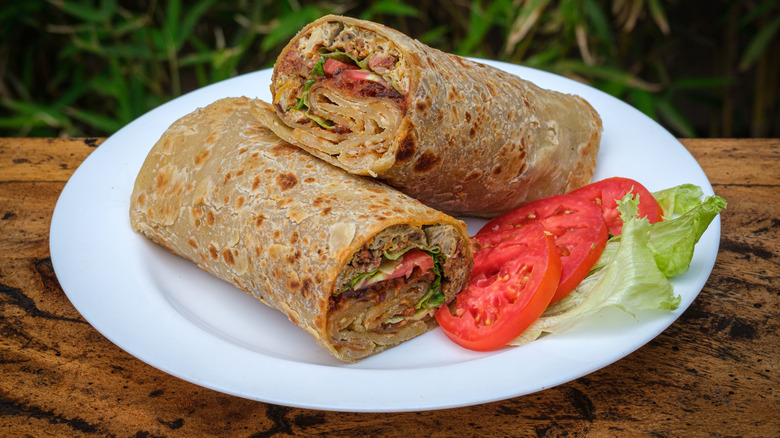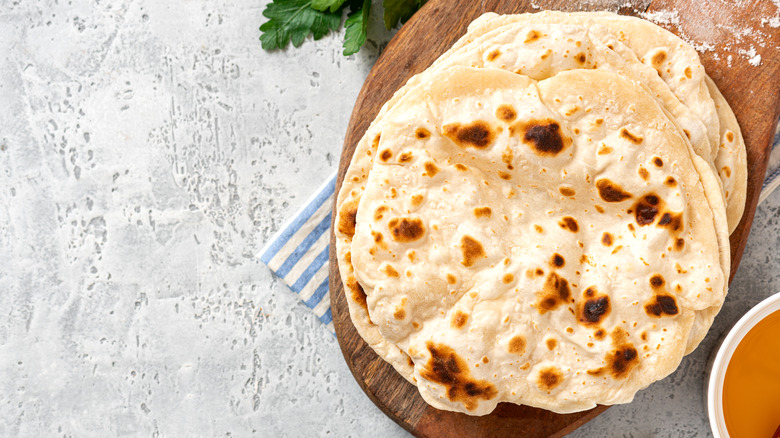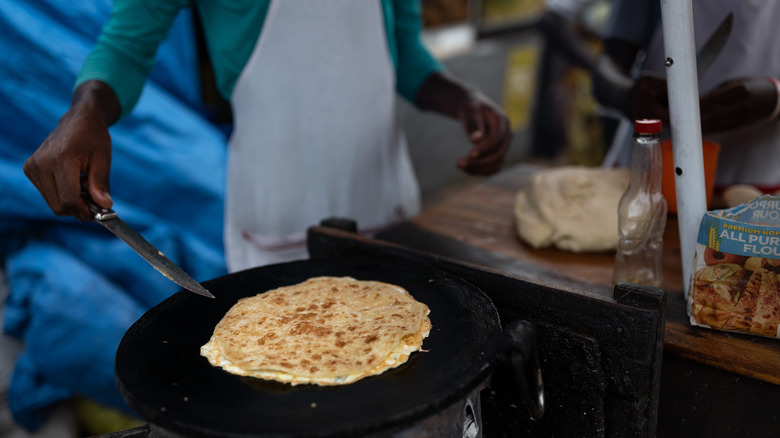In Uganda, Rolex Isn't Just A Watch, It's A Popular Rolled Egg Dish
If you're ever on a street corner and hear someone shouting that they're selling "Rolex," you should probably walk the other way. Unless, of course, you are in Uganda, in which case you should consider stopping for a tasty breakfast or lunch treat. As The New York Times explains, in Uganda, "rolex" is actually the name of a popular street food made with a combination of whipped eggs and fresh vegetables, not dissimilar to an omelet, which is then rolled in a chapati flatbread and often served wrapped in paper for easy handling.
Why do vendors sound like they're selling black-market watches, then? The dish came by its name due to a common misunderstanding. In the dish's early days, vendors would shout "rolled eggs" repeatedly. The syllables tended to run together after awhile and they would end up calling out "roll eggs," which, in a crowded market, began to sound to many European and American visitors like "Rolex," causing some confusion. The misconception was amusing enough that it caught on, and the egg dish has been called a "rolex" for years.
New dish, old ingredients
While the rolex has become a fast-food staple throughout Uganda, the dish is actually a relative newcomer on the culinary scene. Its popularity has been credited to a lone street vendor near Makerere University in Kampala, where it became a student favorite before catching on in other areas. The ingredient that makes the rolex special, though, has a longer, more complicated history.
Chapati is a form of flatbread that originated in India, where it remains popular. How, then, did it become a staple food in countries like Uganda and Kenya? The migration of Indian foods to African culture is a byproduct of European colonialism. According to Whetstone Magazine, many Indian dishes found their way to Eastern Africa when British colonists started building railroads through the region. Many of the workers brought in to handle the physical labor were from India. They brought with them recipes for simple staples like chapati — which only requires four or five ingredients — which local laborers took a liking to. Indian merchants who chose to stay in Africa employed African workers and sometimes paid them in food staples like flour and salt, leading locals to replicate the foreign recipes and create their own variations over time. As a result, chapatis are as ubiquitous in African cuisine today as they are in Indian food, with many families serving them regularly for occasions ranging from weeknight dinners to holiday feasts.
Simple recipe
While it is a fairly new dish, the rolex is not a particularly complicated snack to make, which probably explains its popularity among street vendors and students. Presuming you've already got your chapati made – which involves rolling out and frying dough made of water, wheat flour, salt, vegetable oil, and possibly sugar — all you need to do is basically make an omelet.
Aside from eggs, most rolexes include a combination of finely chopped produce — primarily cabbage, onions, and tomatoes, though other ingredients like carrots, chilis, and grilled meats can also be added in some variations. Mix up the eggs, veggies, and a bit of salt in a large mug, then pour them into a heated, oiled skillet and spread the egg mixture out thinly like an omelet. When it starts to brown, flip the flat egg disc over and begin to cook the other side. As it cooks, lay the flattened chapati over it to warm it up, then after a minute or two, flip the entire skillet out onto a plate or piece of newspaper. All that's left to do is roll up the chapati into a sort of egg burrito and wrap it in the paper to serve! The whole process only takes a few minutes and is an ideal meal on the go.


